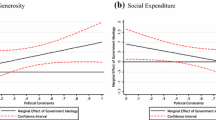Abstract
Inspired by public choice theories — in particular the work of Bernholz, Downs, Olson and Tullock — two propositions are advanced. First, the older a democracy is, the slower its growth rates should become. Second, the higher the social security spending is, the slower economic growth rates should become. Pooled regression analysis and the growth experience of 19 OECD nations between 1960 and 1985 allow for an empirical test. Unfortunately, results very much depend on a technical issue, i.e., on the inclusion or exclusion of period and country dummy variables. It is argued that inclusion of the dummies is misleading. If you accept these arguments, then the propositions linking age of democracy or social security transfers on the one hand and lower economic growth rates on the other hand are confirmed.
Similar content being viewed by others
References
BernholzPeter (1977). Dominant interest groups and powerless parties.Kyklos 30(3): 411–420.
BernholzPeter (1986). Expanding welfare state, democracy and free market economy: are they compatible?Zeitschrift für die gesamte Staatswissenschaft 138(3): 583–598.
BernholzPeter (1986). Growth of government, economic growth and individual freedom.Journal of Institutional and Theoretical Economics 142(4): 661–683.
BorcherdingThomas E. (1985). The causes of government expenditure growth: a survey of the U.S. evidence.Journal of Public Economics 28: 359–382.
BrunnerKarl (1978). Reflections on the political economy of government: the persistent growth of government.Schweizerische Zeitschrift für Volkswirtschaft und Statistik 114(3): 649–680.
CameronDavid (1985). Public expenditure and economic performance in international perspective. In RudolfKlein and MichaelO'Higgins (eds.),The Future of Welfare, Oxford: Basil Blackwell, pp. 8–21.
CastlesFrancis G. and SteveDowrick (1990). The impact of government spending levels on medium-term economic growth in the OECD, 1960–85.Journal of Theoretical Politics 2(2): 173–204.
ChoiKwang (1983a). A statistical test of Olson's model. In Dennis C.Mueller (ed.),The Political Economy of Growth. New Haven: Yale University Press, pp. 57–78.
ChoiKwang (1983b).Theories of Comparative Economic Growth. Ames, Iowa: Iowa State University Press.
DemsetzHarold (1982).Economic, Legal and Political Dimensions of Competition. Amsterdam: North-Holland.
DownsAnthony (1957).An Economic Theory of Democracy. New York: Harper and Row.
GrayVirginia and DavidLowery (1988). Interest group politics and economic growth in the United States.American Political Science Review 82(1): 109–132.
GrossmanPhilipp J. (1987). The optimal size of government.Public Choice 53(2): 131–147.
JagodzinskiWolfgang and ErichWeede (1981). Testing curvilinear propositions by polynomial regression with particular reference to the interpretation of standardized solutions.Quality and Quantity 15(4): 447–463.
KorpiWalter (1985). Economic growth and the welfare state: leaky bucket or irrigation system?European Sociological Review 1(2): 97–118.
KuznetsSimon (1966).Modern Economic Growth. New Haven, Conn: Yale University Press.
LandauDaniel T. (1985). Government expenditure and economic growth in the developed countries 1952–76.Public Choice 47(3): 459–477.
LaneJan-Erik and SvanteErrson (1986). Political institutions, public policy and economic growth.Scandinavian Political Studies 9(1): 19–34.
Maddison, Angus (1982).Phases of Capitalist Development. Oxford University Press.
McCallumJohn and AndreBlais (1987). Government, special interest groups, and economic growth.Public Choice 54(1): 3–18.
NorthDouglass C. (1985). The growth of government in the United States: an economic historian's perspective.Journal of Public Economics 28: 383–399.
NieNorman H. and SidneyVerba (1975). Political participation. In Fred L.Greenstein and Nelson W.Polsby (eds.),Handbook of Political Science, Vol. 4: Nongovernmental Politics. Reading: MA: Addison-Wesley, pp. 1–74.
OECD (1983).Historical Statistics 1960–1981. Paris: OECD.
OECD (1984).Historical Statistics 1960–1982. Paris: OECD.
OECD (1987).Historical Statistics 1960–1985. Paris: OECD.
OlsonMancur (1965).The Logic of Collective Action. Cambridge, MA: Harvard University Press.
OlsonMancur (1982).The Rise and Decline of Nations. New Haven, Conn.: Yale University Pres.
PryorFrederic L. (1984). Rent-seeking and the growth and fluctuations of nations. In David C.Colander (ed.),Neoclassical Political Economy: The Analysis of Rent-Seeking and DUP Activities. Cambridge, MA: Ballinger, pp. 155–175.
SaundersPeter (1986). What can we learn from international comparisons of public sector size and economic performance?European Sociological Review 2(1): 52–60.
SchumpeterJoseph A. (1942).Capitalism, Socialism and Democracy. New York: Harper and Brothers.
TullockGordon (1980). The welfare costs of tariffs, monopolies and theft. In James M.Buchanan, Robert D.Tollison, and GordonTullock (eds.),Toward a Theory of the Rent-Seeking Society. College Station: Texas A and M University Press, pp. 39–50.
TullockGordon (1983).Economics of Income Redistribution. Boston-The Hague-London: Kluwer Nijhoff.
WallisJohn J. and Wallace E.Oates (1988). Does economic sclerosis set in with age? An empirical study of the Olson hypothesis.Kyklos 41(3): 397–417.
WeedeErich (1984). Democracy, creeping socialism, and ideological socialism in rent-seeking societies.Public Choice 44(2): 349–366.
WeedeErich (1986a).Konfliktforschung. Opladen: Westdeutscher Verlag.
WeedeErich (1986b). Catch-up, distributional coalitions and government as determinants of economic growth or decline in industrialized democracies.British Journal of Sociology 37(2): 194–220.
WeedeErich (1986c). Sectoral reallocation, distributional coalitions and the welfare state as determinants of economic growth rates in industrial democracies.European Journal of Political Research 14(5–6): 501–519.
WeedeErich (1987). A note on Pryor's criticism of Olson's Rise and Decline of Nations.Public Choice 52(3): 215–222.
WeedeErich (1988). Schleichender Sozialismus, Marktvermachtung und Stagnation.Politische Vierteljahresschrift, Sonderheft 19 (Staatstätigkeit): 88–114.
Weede, Erich (1990a). Redistribution and income inequality in industrial democracies. In Louis Kriesberg (ed.),Research in Social Movements, Conflicts and Change Vol. 12: pp. 301–326.
WeedeErich (1990b).Wirtschaft, Staat und Gesellschaft. Tübingen: Mohr.
Author information
Authors and Affiliations
Rights and permissions
About this article
Cite this article
Weede, E. The impact of state power on economic growth rates in OECD countries. Qual Quant 25, 421–438 (1991). https://doi.org/10.1007/BF02484590
Issue Date:
DOI: https://doi.org/10.1007/BF02484590




